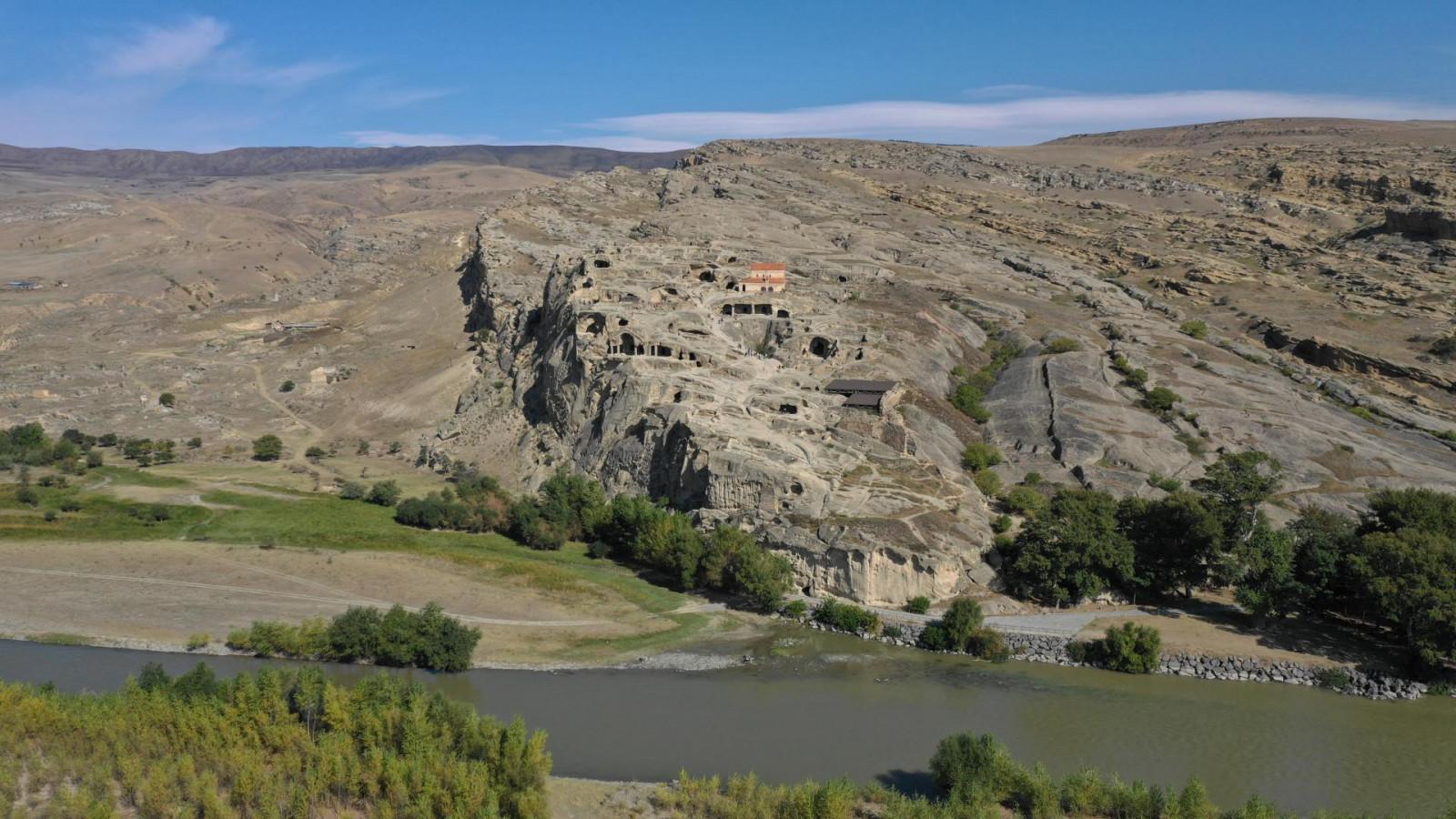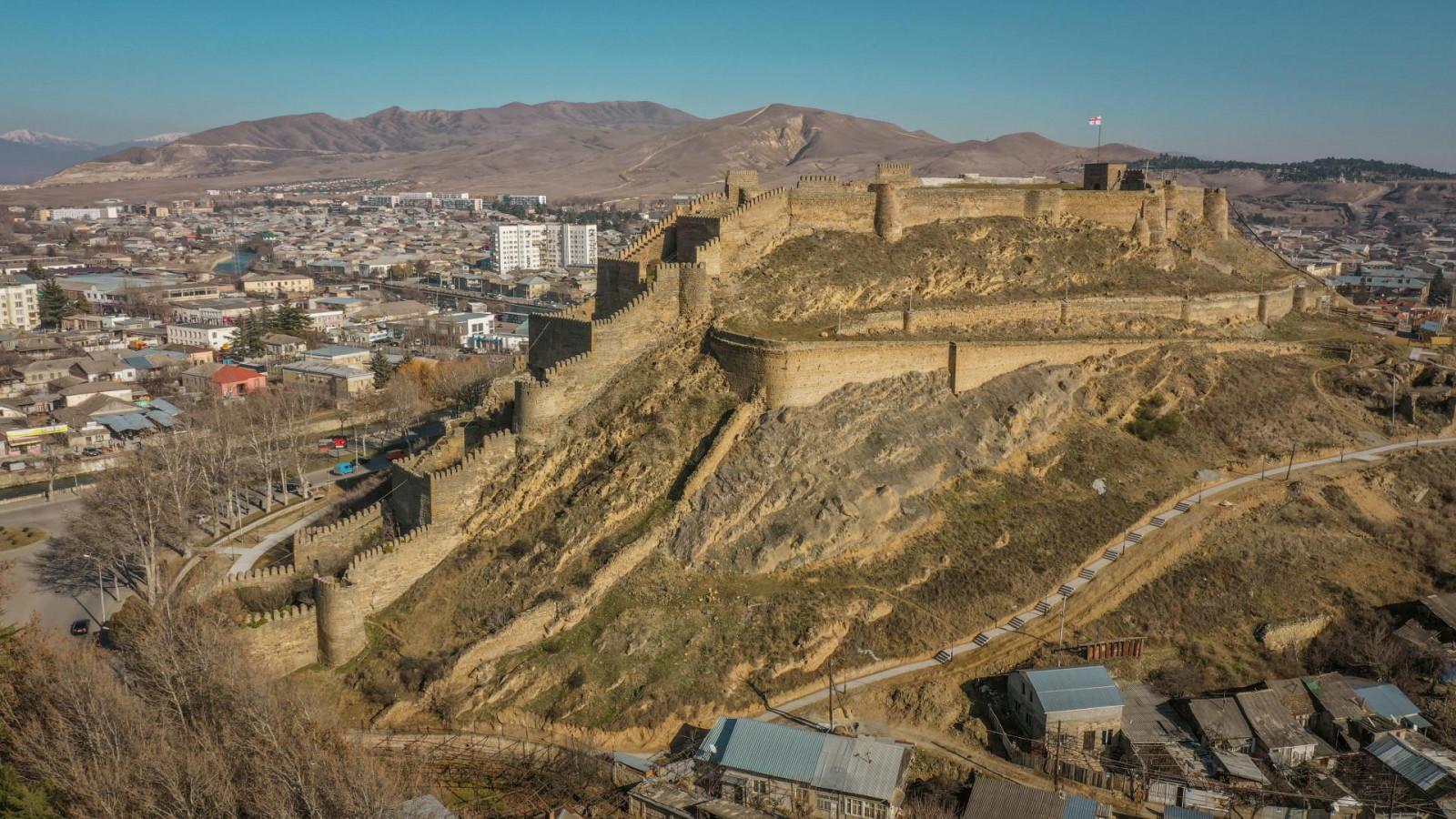
Gori in One Day
It is almost impossible not to mention the city of Gori. It is a place of national importance due to its location. It is connected to Tbilisi by the main highway, but it is not often, mentioned as a short hiking spot.
Gori is mostly associated with the Stalin Memorial Museum in the city center, which has become the city's symbol and is of particular interest to tourists. Gori municipality, rich in cultural monuments and beautiful nature, has a great history. It is an ideal place for a picnic, and small hikes. You will see beautiful valleys, waterfalls and small lakes here. Gori Fortress plays a major role in the city. Among the main sights are the Gori Cathedral, the Gori Theater, and the Ethnographic and Historical Museum, which is as important as the Stalin Museum.
You will meet many historically, geographically, and culturally important places in Gori Municipality. A few kilometers away from Gori there is a famous example of old Georgian ecclesiastical architecture, the 7th-century cross-domed temple of Ateni Sioni. The ancient city of Uplistsikhe, which dates back to the VII century, is also located here. Apart from these sights, there is a balneological resort of Gorijvari and many other interesting, artistic, and historical temples, settlements, fortresses, the monastery complex of the deity of Zemo Nikozi, and the fortress of Shindisi.
The city is ideal for short-term visits and hiking. You will not be able to see all the historical and cultural monuments and enjoy the beauty of nature in one day, that's why we offer you the sights you will be able to see in a day.
Gori Fortress
Gori Fortress has become a symbol of the city. The historical fortress stands in Kartli, in the center of the city of Gori, on a high rocky hill. Ruins and archeological artifacts on the northern slope prove that in the last centuries of the first millennium BC, there was a strong fortress and population around it. "Gori Fortress" is first mentioned in the sources in the XIII century.
Gori Fortress was an important strategic fortress; Seizing it meant political domination over the whole of Shida Kartli. Gori Castle has been renovated and rebuilt many times over the centuries. The main part was restored in the 30s of the XVII century by King Rostom.
The fortress is built of cobblestone; In the earlier layers, the cut stone is used. According to the plan, the oval citadel is surrounded by a relatively better-preserved part from the west - "Tskhrakara"; To the south and east, there are auxiliary fences. The original entrance to the castle is not visible; In the middle of the south wall, there is a late arched gate. In the south-eastern section, there are the ruins of a small church. The castle had a tunnel to drain water and a reservoir. Gori Fortress was significantly damaged by the 1920 earthquake.
The castle got the present look in 1774 when it was thoroughly repaired by King Erekle II. In the first years of the unification of Kartli-Kakheti with Russia (1801), Gori Fortress still had its strategic function - a battalion of Grenadiers of the Russian Army was stationed here. Then it lost its former role.
Uplistsikhe
The rock-cut town is one of the oldest Caucasian settlements and city centers. It is located in Shida Kartli, 10 km east of the city of Gori, on the left bank of the river Mtkvari. It is the only monument from ancient times which is currently preserved only above ground.
Today it is a historical and architectural museum reserve. The city has streets, squares, a water sewer system, four gates, a secret tunnel that leads to the Mtkvari River, a fence, and so on. Today it is considered an open-air museum.
It is first mentioned in written sources in the VII century. A group of archeological and architectural monuments is preserved in Uplistsikhe and its surroundings, the oldest of which is from the Early Bronze Age and belongs to the Mtkvari-Araks culture (settlements in Lashetkhevi, Gudabertka, Gori). The lower layer of the Katlanikhevi hill settlement is from the end of the Middle Bronze Age.
Legend about Uplistsikhe
According to the legend, Uplistsikhe was built by slaves. The slave was given a pick, half of which was covered with iron to cut the caves and the other half with gold. The slave had to work so much to wear out plain metal, after which he received the gift of freedom and precious metal or gold.
Therefore, two things are clear: one is how much work was done to cut the city and the other is that gold was really mined in Georgia and the legend of the Golden Fleece is not far from the truth.
History
Uplistsikhe ensemble carved in the rock and the settlements around it have a long history. First, the rock-cut city was the settlement of the hegemon of the communities living in the vicinity of Uplistsikhe, then the center of the union of the tribes of "Zena Sopeli" (Shida Kartli), where the leader of this union (father), the Lord (literally headman, the name Uplistsikhe coms from it) sat. From ancient times (VI-IV centuries AD) Uplistsikhe was an urban settlement, which became a major city center in the early Hellenistic period (late IV century - III century). The settlement carved in the old rock was formed as the inner city of the ancient city. From the 4th century Uplistsikhe, like some other cities of the earlier period, lost its role and had only strategic importance. During the fight for the unification of Georgia (IX-X centuries) the weakened fortress-town Uplistsikhe passed from hand to hand.
In the IX-X centuries Georgian kings, princes of Kakheti, and kings of Armenia fought for supremacy in Uplistsikhe. After the political unification of Georgia (970s), Uplistsikhe gradually lost its importance. This process ended with the liberation of Tbilisi in 1122 by David IV Aghmashebeli.
Uplistsikhe was the residence of the leader of the local tribes. He had a great power then and the name derives from here - fortress of the lordlike - Uplistsikhe (Upali - lord, Tsikhe - fortress).
Architecture
Uplistsikhe is located on the southern slope of Kvernaki ridge, in an easily processed sandstone massif. It consists of three parts and contains components typical to the ancient eastern countries and the inner city of antiquity: a fence, a trench, several entrances, a tunnel, an aqueduct, and a network of canals. Antique rock halls and buildings are distinguished by their large size, geometric precision of plans and architectural forms, and highly artistic decorations. The halls of the feudal era are more carelessly curved, with obvious traces of processing and cutting tools.
In Uplistsikhe, in addition to the rock-cut halls, the remains of ordinary buildings are also preserved. The buildings of antiquity are built of well-smoothed and processed large blocks of limestone. Most of the buildings of the feudal era are built of crushed stone. Airbrick and brick buildings are also preserved on the territory of the city. All the halls of antiquity have one floor. The buildings of the feudal era, are not built with the same principle and that is why most of the caves of this period have collapsed. The rocky slope was surrounded by a cliff to the south and west, and a rock-cut trench to the north and east.
Art House
The Art House was opened in 2020 by members of the Photographers Club of Gori. A series of educational projects and exhibitions were implemented with the assistance of various institutions and local authorities.
Permanent exhibitions of local and international artists are held at the Art House. The main purpose of the space is to promote the development of photography, contemporary art, and culture in general, in the region and the country. It is a regional platform and supports the professional development of many artists.
The multi-sectoral direction is one of the priorities of the space, which encourages the involvement of a wide audience and different areas of the process, and helps to reflect the challenges of the global process.
Gori Historical and Ethnographic Museum
In 1935, the Historical and Ethnographic Museum was opened in Gori, later named after Georgian Ethnographer, Doctor of History, and Professor the Sergi Makalatia.
The museum preserves Archaeological material of IV-III millennia, samples of numismatics, as well as ethnographic material of XVIII-XIX centuries: carpets, rugs (from Georgia and Karabakh), Persian shawl, gold-embroidered church garments, collection of weapons of XVII-XIX centuries.
Here are presented materials reflecting agriculture, cattle breeding, metalwork, wall painting, small sculptures, heraldry and public spectacle, drachmas, coins, Gori treasures, manuscripts, etc.
Stalin House-Museum
The Joseph Stalin Museum Complex was established in Gori after Stalin's death in 1957. However, in the house where Stalin was born, the memorial museum existed since1937 during his lifetime.
Up to 60,000 exhibits are kept here. The museum complex includes the memorial house where Stalin was born, the exhibition building, and Stalin's private car, with which he traveled to historical conferences in Tehran, Yalta, and Potsdam. The museum also preserves Stalin's personal belongings. The museum is located in the city center at 32 Stalin Street.
A Little About Gori
Gori is first mentioned in chronicles from the 7th century. The area has been inhabited since ancient times. The best example is the rock-cut town of Uplistsikhe, whose earliest layers date back to the Bronze Age. Various archaeological sites are also found in the area.
The name of the city comes from the rocky hill erected in the city, on which an old castle is built. Due to its strategic location, Gori was often a target for conquest. In the 1840s, it was liberated from foreign invaders. The region is distinguished by beautiful nature and an abundance of cultural monuments. Many artifacts of cultural, historical, or artistic value have been discovered on the territory of Gori.
The city has light and food industry enterprises, healthcare, education, and cultural institutions. There is also the Eparchy of Samtavisi and Gori. Gori is a railway junction. In addition, the developed transportation system connects the city to Tbilisi and nearby villages. Buses and minibusses run from the park. The city's domestic transport is also developed, which mainly includes minibusses and buses.
If you are looking for different means to get to Gori besides a private car, you can easily get a minibus and private taxis from the Didube metro station. The cost is 4-5 GEL. However, if you want a planned, pre-arranged, and as comfortable trip as possible, start the day trip with Gori Walking Tour.
The tour offers a different, alternative perspective on the way, and with the help of locals, you will discover unfamiliar places that will give you a new image of the city.







Please login to add a comment
Write a comment